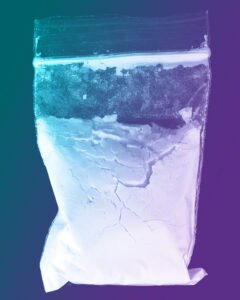Cocaine Cutting Agents

Cutting agents have been around for decades but are rarely a topic of discussion – that is until recent years when fentanyl overdoses have been on the rise. In 2021, 1,305 deaths were caused by cocaine in Florida. However, cocaine was present in 666 deaths where another substance was the cause. This could mean that substances could have been added to the cocaine or vice versa. So, what substances are most likely to have a cutting agent? What are the most common agents to use? Today, we will take a look at different cocaine cutting agents and the dangers they possess.
What Are Cutting Agents?
Cutting agents are used in order to dilute a substance in order to increase volume. For example, if you have two cups of flour and add one cup of sugar, you now have three cups of dry ingredients to work with. The same principles apply to illegal substances. By adding in a cheap “filler,” the product is now sold for the same price and more can be distributed.
There are different types of cutting agents. Diluents are essentially only fillers, adding weight so the substance can be sold for the same price using less product. Adulterants are used to enhance the effects of the substance, like adding fentanyl to heroin.
What Is Cocaine Cut With?
The most common diluents used to cut cocaine are:
- Boric acid
- Fructose/glucose
- Laundry detergents
- Starch
- Talc
Some common adulterants used are:
- Ibuprofen
- Acetaminophen
- Caffeine
- Codeine
- Levamisole
The goal is to use the cheapest products in order to extend profits without too much overhead. Because cocaine is illegal, there is no regulation on cutting agents or dosage.
The Dangers of Cocaine Cutting Agents
 Diluents pose a smaller risk when it comes to cocaine use. Most cause an increase in nasal irritation or nausea, but because they are mostly food-based, they are safe to be ingested. However, cocaine is a stimulant, and adding another stimulant such as caffeine can be dangerous. Stimulants increase heart rate and can lead to heart attacks or strokes.
Diluents pose a smaller risk when it comes to cocaine use. Most cause an increase in nasal irritation or nausea, but because they are mostly food-based, they are safe to be ingested. However, cocaine is a stimulant, and adding another stimulant such as caffeine can be dangerous. Stimulants increase heart rate and can lead to heart attacks or strokes.
Levamisole has been widely gaining popularity as a cocaine cutting agent. Normally used as a dewormer in cattle, this substance is known to cause skin lesions, necrosis, and purpura when mixed with cocaine. Purpura is when small blood vessels leak blood under the skin creating a purple spot rash. It is used to add weight and also extends the effects of cocaine.
When cocaine is mixed with heroin, it is known as a speedball. The effects of both substances seem to cancel each other out since one is a stimulant and the other a depressant. This can lead to taking more of the substances and increases the risk of overdose. Heroin and cocaine also risk being cut with fentanyl – an opioid that is 50 to 100 times more powerful than heroin alone. Symptoms of fentanyl overdose include:
- Coma
- Pinpoint pupils
- Cold or clammy skin
- Respiratory depression
- Discoloration especially of the lips and nails
Opioids can mask the symptoms of a cocaine overdose. These include:
- Increase body temperature
- Profuse sweating
- Chest pain
- Nausea or vomiting
- Seizures
The cocaine timeline is relatively short, but the substances that are used to cut cocaine can linger longer and pose more concerns. In around 15-30 minutes, cocaine will have substantially “worn off,” meaning that the person may think they can take more and be fine. But if the cocaine is mixed with heroin or fentanyl, the chance of overdose increases exponentially.
Cutting Vs. Lacing
Cutting and lacing are similar terms used when dealing with illicit substances. Cutting is a more commonly used term as it means adding either diluents or adulterants to substances. Lacing refers to when adulterants are added to substances.
Cocaine Addiction Treatment
Cocaine can wreak havoc on the mind and body. If you or someone you love is managing a cocaine use disorder, help is not far away. At Clean Recovery Centers, we have helped hundreds of our clients to get clean, live clean, and stay clean. Our cocaine addiction treatment includes inpatient, residential, and outpatient services. An initial assessment will be done to see which option will work best.
Cocaine Detox
While a medical detox is not necessary for cocaine, the staff at Clean Recovery Centers is able to address any physical concerns as well as mental. Physical withdrawal symptoms can be managed with over-the-counter medications. The important thing is to have a strong support system, which can begin in group therapy at Clean Recovery Centers. Cocaine cravings can last months and even years, and having people to talk to can make a big difference in preventing relapse.
Residential / Inpatient Rehab Services
There are two stages to our residential treatment program.
Residential One – This is part of phase one of the treatment program. Individuals are in a 24-hour, 7-days-a-week, live-in environment. Medical support is available if needed, but the main focus is on individual, group, and family therapy. The length of stay in this treatment phase is 3-4 weeks.
Residential Two – This is where the transition to phase two happens. Phase two is the action phase, where individuals confront where the addiction started and prepare themselves for independent recovery. At Clean Recovery Centers, this step is referred to as day/night treatment, or DNT. While most clients choose to live in community housing on-site for this phase, it is not required. The program is a minimum of 30 hours of services per week. The four main focuses of DNT include experiential processes, defense mechanism identification, belief system exploration, and symbolic integration. All of these components are to help transition core beliefs and develop balance to a clean life. This phase of treatment typically lasts 2-3 weeks.
Mental Health Path – For those who have been diagnosed with a mental health condition during phase one, the treatment path can change to accommodate those needs first. Clients go into a residential II setting and receive specific treatment for their diagnosis as well as education and medication management.
Outpatient Rehab Services
Phase Three of the treatment process is the maintenance stage. At Clean Recovery Centers, we have two versions of outpatient services, intensive outpatient and outpatient. For intensive outpatient, or IOP, the client can choose to reside in a 24/7 monitored transitional living on-site or at home. The program is 9 hours per week minimum and continues with individual counseling. Outpatient is for those living at home or in sober living off-site and is 2 hours per week. Both services build on the skills learned in inpatient treatment and therapies to continue on the path to living heroin free. The length of stay for phase three is around 6-8 weeks.
Cocaine use disorder can be life-threatening, especially when it comes to cutting agents. At Clean Recovery Centers, our staff provides educational tools and arms our clients with knowledge and support to get clean, live clean, and stay clean. Call us today at (888) 330-2532 to learn more about our unique program and therapy options.
FAQs Cocaine Cutting Agents
What is the most common agent cocaine is cut with?
The most common agents that cocaine is cut with are talc, boric acid, or acetaminophen.
Why is cocaine cut with other agents?
Cocaine is cut in order to stretch inventory so dealers can make more profit using less product. It is also cut to create a stronger “high” and keep the person coming back for more.
Is it possible to remove foreign agents from cocaine?
Due to the way that cocaine is made, there is no way to remove foreign agents. Cocaine is a powder and is cut with powder forms of other substances, and there is no way to separate them once mixed.


